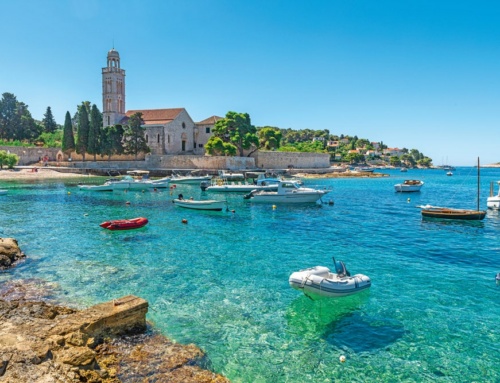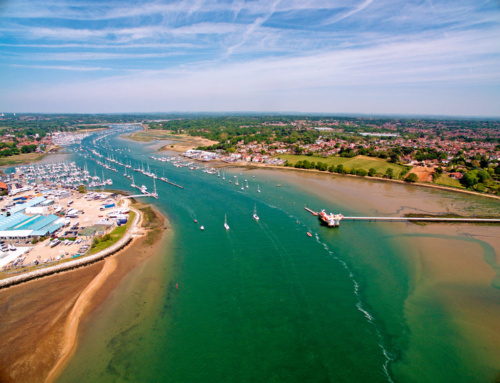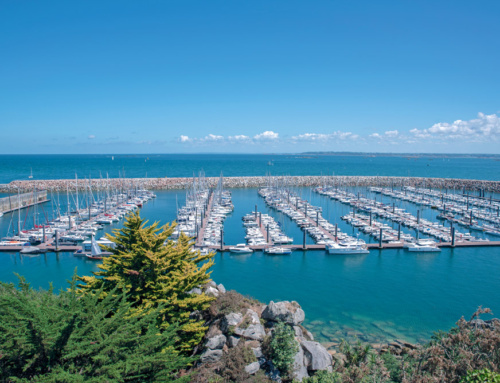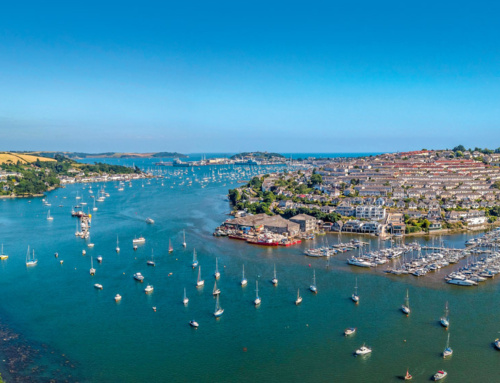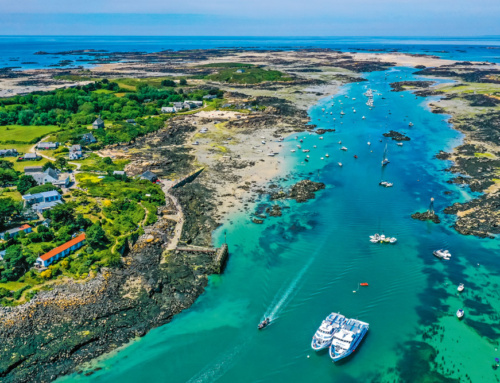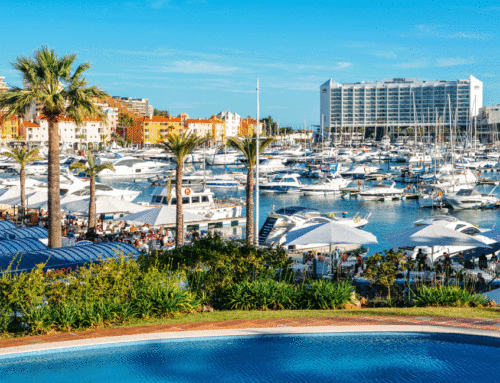- The sandy areas temporarily revealed by the retreating tide are spectacularly pretty, and provide uncrowded and sheltered areas for swimming, snorkelling and paddleboarding.
- The chance of having one’s own private desert island on a hot and sunny afternoon explains the huge allure of the two reefs …
- Even visiting these reefs as often as I do … I still feel the same sense of wonder on each visit.
Cruising Jersey’s Famous Reefs
Joe Mourant describes some of the pleasures to be enjoyed in this spectacularly beautiful part of the Channel Islands …
Jersey, the biggest of the Channel Islands, has one of the largest tidal ranges in the world. For those, like myself, fortunate enough to be able to explore its coastline and the surrounding waters by means of a RIB or powerboat, this dramatically shifting body of water means that there’s an enormous variety of different cruising grounds to visit, many of which will be completely unrecognisable at opposite ends of any given six-hour tidal cycle. There are sheltered bays and coves, small harbours and anchorages, and a range of fortifications dotting the coastline from enormous medieval castles to German bunkers dating back to WWII.
In recent years, visitors to the island have been able to explore some of Jersey’s offshore beauty spots by charter RIB – certainly the best way to see the full extent of such challenging tidal habitats and the wildlife they support. I work for Le Mourier, an RYA powerboat training school and a provider of such trips. This affords me the opportunity to visit our neighbouring Channel Islands and the coast of France on a weekly basis in the course of my job, and to teach others how to safely traverse the two offshore reefs Jersey is famous for, namely Les Écréhous and Les Minquiers.
Even visiting these reefs as often as I do (dozens of times each year), I still feel the same sense of wonder on each visit. It is impossible not to – with changing tides, weather and wildlife, no two trips are ever exactly the same. A gannet can come diving out of the sun and dramatically break the surface of the water. Cormorants suddenly appear from the depths, take a short breath and then disappear again for impossibly long moments. Seals can accompany the boat as we pass through, or a pod of dolphins can appear and spend half an hour leaping and diving on all sides before disappearing just as abruptly as they arrived.
Charters to these reefs account for a large proportion of our private charter work, and as aspiring or new boat owners will naturally want to visit these incredible natural habitats as they grow in ability and confidence, we tend to build in navigational exercises involving them when running the more advanced powerboat courses.
Both Les Écréhous and Les Minquiers have very small areas permanently sat just above sea level. A small number of dwellings have been built upon these rocks, in some cases the best part of two centuries ago. The vast majority of these houses are in private ownership, and those fortunate enough to own them sink private moorings and visit regularly, especially during favourable weather. Neither reef has permanent year-round inhabitants, electricity or plumbing.
On a spring tide, the sea will be just metres below the front doors of some of these properties, many of which are totally isolated on their own individual pinnacles of rock. This can lead to a surreal boating experience, as it becomes possible to guide one’s boat between different houses over a high spring tide.
The extreme changeability of each terrain explains a great deal of the attraction for visitors to these two reef systems, as over the course of a 12-metre tidal range they can change from being just a few houses perched above a surging 5-knot tide to isolated hamlets amid vast swathes of beautiful sand, rock pools and kelpy rocks. Seabirds, seals and dolphins are all prevalent in the reefs and their surrounding waters, and each has recently received comprehensive protection from commercial fishing.
The sandy areas temporarily revealed by the retreating tide are spectacularly pretty, and provide uncrowded and sheltered areas for swimming, snorkelling and paddleboarding. The chance of having one’s own private desert island on a hot and sunny afternoon explains the huge allure of the two reefs, although Les Écréhous is by far the busier of the two. There can be several dozen vessels – sail and power, French and Jersey – on a weekend day with nice weather. Les Écréhous also has much easier pilotage to follow in order to access it, meaning that boaters of all levels of confidence attempt to visit (not always safely, or successfully!).
In addition to powerboat courses and charters, Le Mourier also runs a cruising club. We have around a dozen different boats that join us on cruises, and whose owners receive either practical or theory instruction from us each month. Cruising in company offers the perfect opportunity to visit some of the more challenging locations around Jersey’s coast and feel more confident when doing so.
On a recent cruise to the Les Minquiers reef with our cruising club, we were joined by an interesting mix of vessels. Guiding the group, I was on our XS850 RIB, powered by twin 200hp Verados. This is our main charter RIB and is also used to teach RYA Intermediate and Advanced Powerboat courses. Acquired in January 2017, she has proved her worth repeatedly this season, often facing daunting seas the likes of which have accounted for many of the shipwrecks littering the Channel Islands. And she is well used: during the busy months, we put 150–200 hours on each engine per month.
The owner of Le Mourier, Malcolm Parris, was on another of our boats, a Beneteau Antares 1080. Accompanying us was an X0360 with twin Volvo D6s (370hp each), an Axopar 28 Cabin with a 350 Mercury Verado, an Axopar 37 Cabin boasting twin 350 Mercury Verados, a Regal 2650 with a V8 MerCruiser engine and another Beneteau Antares 1080. Each vessel had full safety equipment, and the skipper of each was known to us and so had, we felt, a level of competency suitable for a cruise with more challenging pilotage.
Our aim was to anchor in the lagoon formed by Les Minquiers’ famous sandbank over an exceptionally low spring tide. Accordingly, all vessels mustered outside St Helier marina just before half tide, passage plans were agreed, a dedicated VHF channel was chosen and our flotilla set off. With the Les Minquiers reef being due south of Jersey, and approximately 12 miles away, we weren’t looking at a long trip; the ‘slowest’ vessel in the fleet was the Antares, which has a comfortable cruising speed of around 20 knots. The Axopars, the XO360 and our RIB will all easily exceed 40 knots (if reasonable fuel economy isn’t required, of course), and so there were some decided front-runners as we powered our way south!
The plan was to rendezvous at a starboard lateral buoy, named the Demie de Vascelin, signifying the start of the reef. Upon converging at that point, all of the vessels would form up in single file and follow me in our XS using a narrow channel we take to access the reef. At half tide, there’s 7 metres of water at the deepest points in this channel, but the channel itself is very narrow and the tide will recede to nearly chart datum height during a low spring tide. There are also choke points entering the reef, where one will need to pass between submerged (but definitely strikeable) rocks.
Intimate knowledge of the route is required, and using a tidal curve to keep track of how much water is ‘on’ at any given moment is the key to executing this type of pilotage. All modern chartplotters should include a real-time tidal curve, and this is a tool of enormous value in such areas. When we teach the use of tidal curves and tidal depth calculations during our powerboat courses, they can seem rather an archaic skill; however, making this type of trip is a far safer proposition with a full understanding of precise tidal heights hour to hour when the high tide might reach 12 metres and the low 0.75 metres!
Once the flotilla had entered the reef system, we proceeded in single file and maintained close radio contact. There are obvious risks when following power vessels through treacherous waters due to each vessel’s differing draught, the chance of slight deviation from the safe course and from vessels in front creating wash, which obscures water visibility for those following. Provided there is no glare on the water, Jersey’s waters have very good visibility, which, for shallow-draught boats, can sometimes enable exploration by sight in areas with lots of sand such as Les Minquiers. Put simply, avoid the dark areas!
Upon arriving at the sandbar, it was time to position the boats within the lagoon we know from experience is created at low tides. The sandbar forms a perfect natural barrier from the open sea, leading to the most amazing mirror-like conditions within the lagoon itself. With a bit of experience, it is possible to anchor in only 2 or so metres of water, as, with a single exception, the lagoon is free of rocks.
Once anchored, it was time for tenders – or paddleboards – to be launched and for everyone to decamp to the sandbar itself. Adrian and Claire – owners of the XO360 – decided to fire up a portable BBQ, and generously provisioned everyone with delicious bacon rolls. We then passed an idyllic afternoon in the sun, and the only boats at the reef that day belonged to our small flotilla. Paddleboards and tenders offer the perfect way to explore the lagoon.
Once the tide had turned, we took a different route out of the reef, passing through narrow channels only a couple of metres deep. Again, single file was adhered to, as was the speed limit of 5 knots within the reef itself. Once we had passed beyond the extent of the reef, it was time to make the most of the glassy seas as we powered towards home.
Le Mourier Powerboat School
The Channel Islands’ largest powerboat training school. With a fleet of training vessels, Le Mourier teaches powerboating from novice to Yachtmaster level. As well as welcoming students from the UK, Le Mourier also offers private powerboat charters, tours and trips exploring Jersey and the surrounding Channel Islands, and the French coast.
History of Les Écréhous
Les Écréhous are a group of islands and rocks situated 6 miles north-east of Jersey and 8 miles from France. They form part of the Bailiwick of Jersey. Sovereignty was settled by a court case at the International Court of Justice, which in 1953 awarded both Les Écréhous and Les Minquiers the status of reefs to Jersey.
The reef system – protected under the Ramsar Convention – supports thriving colonies of seabirds and also a healthy seal population.
History of Les Minquiers
Les Minquiers (nicknamed locally the ‘Minkies’) are just under 10 miles south of Jersey. At low tide, the habitat of rocks and sandbars covers an area larger than Jersey itself. At high tide, there are just a few dozen square metres remaining above sea level.
For hundreds of years, Les Minquiers were a refuge for fishermen, and a handful of small stone fishermen’s ‘huts’ dating back to the 18th century are the only dwellings within the reef. Rock was quarried from the reef by Jerseymen around this time, and scratches the quarrymen made on rocks dating back to the 1850s can still be found on Maîtresse Île, the main island.
Cruise Participant Comments
Paul Robinson, skippering the Regal 5.0L V8 2650:
‘As someone who is new to boating, joining the Le Mourier Powerboat Group has proved invaluable to me. It has increased my knowledge and confidence to a level I would never have achieved on my own. In around a year, I have gone from complete novice to holding an RYA Advanced Powerboat certificate, which I hope to have commercially endorsed soon.
‘The group and I have developed and executed passage plans, visiting such places as Carteret and Port-Bail in France, the Chausey Islands, Herm, Sark and the Écréhous and Minquiers reefs.’

